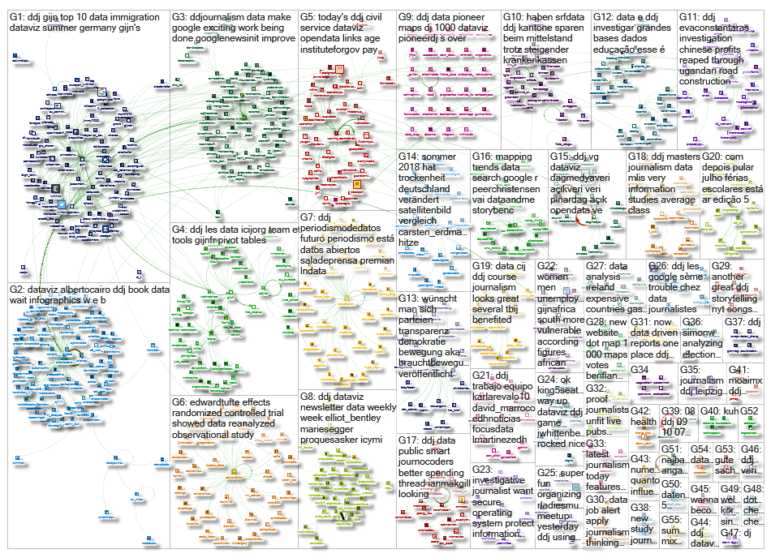What’s the global data journalism community tweeting about this week? Our NodeXL #ddj mapping from Aug 6 to 12 finds @sciam profiling a new color scale for the color blind, @EDudinskij‘s fun dissertation on dataviz in science fiction movies, @morgenpost using satellite imagery to show the consequences of droughts, and @gregladen and Grant Foster calling bull on a climate change denier’s flawed graphs.
The Problem with Rainbow Color Scales
Data visualizations using rainbow color scales can sometimes be misleading and, for those with color blindness, are completely unintelligible. Now scientists at a US Department of Energy lab have developed a color scale — Cividis — that is mathematically optimized to be accurate for both color blind people and those with normal vision.
One for the #dataviz community:
Researchers have developed a new colour scale optimised for accurate reading both for people with colour blindness & without
Love the scatter plots of data difference vs perceptual difference (furthest right is new scale) https://t.co/tbZk1bvlHd pic.twitter.com/07pHHwcDOg
— John Burn-Murdoch (@jburnmurdoch) August 10, 2018
My Big Screen DataViz Dissertation
Here’s a fun dissertation idea by Edvin Dudinskij: analyzing incidences of data visualizations that appeared in science fiction movies.
Collages of scenes where data visualisations appeared in movies such as Blade Runner (1982,2017) and Solaris (1972,2002) – data collected as part of my dissertation on data visualisation in the science fiction movies. 🤓 pic.twitter.com/mz2yfw3i9v
— Edvin Dudinskij (@EDudinskij) August 2, 2018
Visualizing W.E.B Du Bois’ Black America
The colorful charts, graphs and maps presented at the 1900 Paris Exposition by famed sociologist and black rights activist W.E.B. Du Bois offered a view into the lives of African Americans, conveying a literal and figurative representation of “the color line.” Reserve your copy here.
Can't wait for this book: “W. E. B. Du Bois's Data Portraits: Visualizing Black America” https://t.co/E7nC8rkuz8 #dataviz #infographics #ddj pic.twitter.com/XfZZiR7apV
— Alberto Cairo (@albertocairo) August 7, 2018
Using Satellite Images to Show Drought
The consequences of the recent drought in Germany are very visible from space. See how Germany’s landscape has changed before and after the heat wave in this satellite-imagery piece from Berliner Morgenpost.
Before and after satellite imagery reveals the consequences of the extensive drought sweeping across Germany that is projected to cost German farmers at least 2 billion euros @morgenpost https://t.co/QSlNbvu55L pic.twitter.com/vmUoyaD0zT
— Planet (@planetlabs) August 8, 2018
Climate Change: Tricking People with Bad Graphs
There’s a graph going around the internet from climate change denier Steve Goddard, aka Tony Heller, claiming to show that temperature in the US has been declining over the years. Both statistician Grant Foster and evolutionary biologist Greg Laden wrote blog posts calling bull on Goddard’s use of flawed data parameters to prove his point.
Fantastic article by statistician (and my coauthor on several papers) Grant Foster on how to trick people with "clever" temperature graphs. I guess you can only trick those who want to believe this stuff… https://t.co/ukhsI6sGNU
— Stefan Rahmstorf (@rahmstorf) August 12, 2018
ICIJ’s Weapons of Choice
A look at the International Consortium of Investigative Journalists’ favorite data journalism tools, ranging from simple spreadsheets to software designed especially to tackle “big data” such as the #PanamaPapers and #ParadisePapers.
Nine essential tools from ICIJ’s #ddj team including @ProjectJupyter and @Linkurious. Impressive to see how @OpenRefine has stood the test of time.https://t.co/YYPFCilHtW
— Anders Pedersen (@anpe) August 9, 2018
Significant DataViz Developments
Andy Kirk’s biannual round up of significant visualization developments is full of gems. This edition, covering the first half of 2018, includes data visualizations that are in the form of fun play-doh, that tackle important social issues and that showcase remarkable ingenuity.
It’s a good day when your play-doh + data viz project #DayDohViz (https://t.co/pYwPVN6pUR) is mentioned by:@visualisingdata (https://t.co/yIorGISPnN)
AND @flowingdata (https://t.co/x1TXetnDqE)
😆💃📊 pic.twitter.com/XVX7rXrAok
— Amy Cesal (@AmyCesal) August 9, 2018
Mapping Google Trends Data in R
Cognitive scientist Peer Christensen writes a short tutorial on how to get and visualize Google search data with both time and geographical components using the R packages gtrendsR, maps and ggplot2.
#RStats 🗺👀
Mapping search data from Google Trends in R via @storybenchhttps://t.co/i112baYDKk pic.twitter.com/Lj7MIkhOT7— Colin Fay 🤘 (@_ColinFay) August 8, 2018
Free Mapping Course
Texas Tribune’s Darla Cameron and Chris Essig will teach a free online course on mapping for journalists from August 27 to September 23, organized by the Knight Center for Journalism in the Americas at the University of Texas.
Free #maptastic MOOC by @utknightcenter: Intro to Mapping and GIS for Journalists
Very cool and importantfuls!
Register ASAP (it starts Aug 27): https://t.co/W5dCYoqHXA pic.twitter.com/a0XRDEzMZk
— kate (@pokateo_) August 8, 2018
Future of Journalism in Open Data
The second episode of Colombia’s Canal Trece #ElDato program focuses on taking advantage of open data to turn them into complete investigations. It highlights the data journalism work by La Silla Vacía and Connectas and speaks to journalists Claudia Báez and Mariana Santos about this journalism discipline.
#DatosAbiertos son una gran oportunidad para el periodismo. Se están aprovechando para “convertirlos en completas investigaciones que están transformando la información, es el renacer de este oficio”. https://t.co/1ntNirkhaO
— Hangouts Periodismo (@HangoutsPer) August 11, 2018
Thanks, once again, to Marc Smith of Connected Action for gathering the links and graphing them.
 Eunice Au is GIJN’s program coordinator. Previously, she was a Malaysia correspondent for Singapore’s The Straits Times, and a journalist at the New Straits Times. She has also written for The Sun, Malaysian Today and Madam Chair.
Eunice Au is GIJN’s program coordinator. Previously, she was a Malaysia correspondent for Singapore’s The Straits Times, and a journalist at the New Straits Times. She has also written for The Sun, Malaysian Today and Madam Chair.

